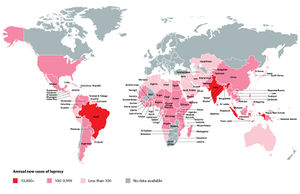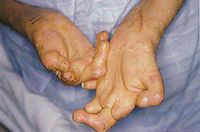Mycobacterium leprae -- Leprosy: Difference between revisions
| Line 30: | Line 30: | ||
===Epidemiology=== | ===Epidemiology=== | ||
[[Image:leprosyMap.jpg|thumb|300px|left| Map of new leprosy cases annually (2010) From: Leprosymission.org [http://www.leprosymission.org/assets/images/leprosyMap.jpg]]] | [[Image:leprosyMap.jpg|thumb|300px|left| Map of new leprosy cases annually (2010) From: Leprosymission.org [http://www.leprosymission.org/assets/images/leprosyMap.jpg]]] | ||
<i>Mycobacterium leprae</i> is thought to have originated in East Africa and spread across the globe through human migratory trends, reaching the Western world within the last 500 years (Monot). In 2012, the World Health Organization recorded a prevalence of approximately 180,000 cases (WHO). Through eradication efforts, the total number of cases worldwide has decreased, yet the number of new cases each year has remained consistent (Review). Mortality is difficult to measure with leprosy, as the infection is not the immediate cause of death in many cases (WHO). | |||
===Virulence factors=== | ===Virulence factors=== | ||
Revision as of 21:11, 23 July 2013



Etiology/Bacteriology
Taxonomy
| Domain = Bacteria | Phylum = Actinobacteria | Class = Actinobacteridae | Order = Actinomycetales | Suborder = Corynebacterineae | Family = Mycobacteriaceae | Genus = Mycobacterium | Species = M. leprae |
|
NCBI: Taxonomy Genome: Mycobacterium leprae |
Description
Pathogenesis
Transmission
Although much about the transmission of Mycobacterium leprae is unknown, prolonged contact with an infected person increases an individual's chance of becoming infected. Armadillos can harbor the bacteria, but are not seen as a threat to human contraction of the disease. In addition, insects could be possible carriers of Mycobacterium leprae but this is unclear In humans, the bacteria is thought to be passed through skin and nasal mucosa (WHO). One study has demonstrated that large numbers of the bacteria can be found on the skin of infected persons, providing a possible means of transmission (Job). Mycobacterium leprae could also be passed through nasal mucosa like the closely related Mycobacterium tuberculosis (Nature).
Infectious dose, incubation, and colonization
Mycobacterium leprae is not able to be cultured in the lab, which can hinder studies of infectious dose and incubation, however some sources provide estimates for these categories (Review). With a doubling time of 14 days (Shephard), Mycobacterium leprae has the longest doubling time of any studied bacteria (Nature). The World Health Organization states that Mycobacterium leprae has an incubation period of an average 5 years. Humans and armadillos are currently the only known reservoirs of the bacteria, with infected humans accounting for up to 7 billion organisms per gram of tissue (WHO). Mycobacterium leprae mostly lives in the extremities and facial region within macrophages and Schwann cells of the peripheral nervous system (Nature).
Epidemiology

Mycobacterium leprae is thought to have originated in East Africa and spread across the globe through human migratory trends, reaching the Western world within the last 500 years (Monot). In 2012, the World Health Organization recorded a prevalence of approximately 180,000 cases (WHO). Through eradication efforts, the total number of cases worldwide has decreased, yet the number of new cases each year has remained consistent (Review). Mortality is difficult to measure with leprosy, as the infection is not the immediate cause of death in many cases (WHO).
Virulence factors
Waxy exterior
Iron utilization
Macrophage invasion
Schwann cell invasion
Drug resistance
Clinical features

Classification
Type 1
Type 2
Lucio Phenomenon
Diagnosis
Treatment

Prevention
Vaccination
Eradication attempts
Immune Response
Protective immunity and susceptibility
Host defense
Bacterial evasion
References
1 Conway, Tyrrell. “Genus conway”. “Microbe Wiki” 2013. Volume 1. p. 1-2.
Created by Gracen Conway, student of Tyrrell Conway at the University of Oklahoma.
